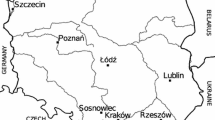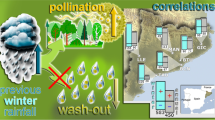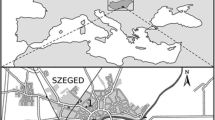Abstract
Constructing accurate predictive models for grass and birch pollen in the air, the two most important aeroallergens, for areas with variable climate conditions such as the United Kingdom, require better understanding of the relationships between pollen count in the air and meteorological variables. Variations in daily birch and grass pollen counts and their relationship with daily meteorological variables were investigated for nine pollen monitoring sites for the period 2000–2010 in the United Kingdom. An active pollen count sampling method was employed at each of the monitoring stations to sample pollen from the atmosphere. The mechanism of this method is based on the volumetric spore traps of Hirst design (Hirst in Ann Appl Biol 39(2):257–265, 1952). The pollen season (start date, finish date) for grass and birch were determined using a first derivative method. Meteorological variables such as daily rainfall; maximum, minimum and average temperatures; cumulative sum of Sunshine duration; wind speed; and relative humidity were related to the grass and birch pollen counts for the pre-peak, post peak and the entire pollen season. The meteorological variables were correlated with the pollen count data for the following temporal supports: same-day, 1-day prior, 1-day mean prior, 3-day mean prior, 7-day mean prior. The direction of influence (positive/negative) of meteorological variables on pollen count varied for birch and grass, and also varied when the pollen season was treated as a whole season, or was segmented into the pre-peak and post-peak seasons. Maximum temperature, sunshine duration and rainfall were the most important variables influencing the count of grass pollen in the atmosphere. Both maximum temperature (pre-peak) and sunshine produced a strong positive correlation, and rain produced a strong negative correlation with grass pollen count in the air. Similarly, average temperature, wind speed and rainfall were the most important variables influencing the count of birch pollen in the air. Both wind speed and rain produced a negative correlation with birch pollen count in the air and average temperature produced a positive correlation.











Similar content being viewed by others
References
Agashe SN, Caulton E (2009) Pollen and spores: applications with special emphasis on aerobiology and allergy. Science Publishers, Enfield
BAF (1995) Airborne pollens and spores: a guide to trapping and counting. The British Aerobiology Federation, Aylesford
Beggs PJ (2004) Impacts of climate change on aeroallergens: past and future. Clin Exp Allergy 34(10):1507–1513. doi:10.1111/j.1365-2222.2004.02061.x
Bousquet PJ, Chinn S, Janson C, Kogevinas M, Burney P, Jarvis D (2007) Geographical variation in the prevalence of positive skin tests to environmental aeroallergens in the European Community Respiratory Health Survey I. Allergy 62(3):301–309. doi:10.1111/j.1398-9995.2006.01293.x
Buters JTM, Kasche A, Weichenmeier I, Schober W, Klaus S, Traidl-Hoffmann C, Menzel A, Huss-Marp J, Krämer U, Behrendt H (2008) Year-to-year variation in release of Bet v 1 allergen from birch pollen: evidence for geographical differences between West and South Germany. Int Arch Allergy Immunol 145(2):122–130
Buters JTM, Thibaudon M, Smith M, Kennedy R, Rantio-Lehtimäki A, Albertini R, Reese G, Weber B, Galan C, Brandao R, Antunes CM, Jäger S, Berger U, Celenk S, Grewling Ł, Jackowiak B, Sauliene I, Weichenmeier I, Pusch G, Sarioglu H, Ueffing M, Behrendt H, Prank M, Sofiev M, Cecchi L (2012) Release of Bet v 1 from birch pollen from 5 European countries. Results from the HIALINE study. Atmos Environ 55:496–505. doi:10.1016/j.atmosenv.2012.01.054
Corden J, Millington W, Bailey J, Brookes M, Caulton E, Emberlin J, Mullins J, Simpson C, Wood A (2000) UK regional variations in Betula pollen (1993–1997). Aerobiologia 16(2):227–232. doi:10.1023/a:1007607307139
Davies RR, Smith LP (1973) Forecasting the start and severity of the hay fever season. Clin Exp Allergy 3(3):263–267. doi:10.1111/j.1365-2222.1973.tb01332.x
Driessen MNBM, van Herpen RMA, Smithuis LOMJ (1990) Prediction of the start of the grass pollen season for the southern part of the Netherlands. Grana 29(1):79–86
Efstathiou C, Isukapalli S, Georgopoulos P (2011) A mechanistic modeling system for estimating large-scale emissions and transport of pollen and co-allergens. Atmos Environ 45(13):2260–2276. doi:10.1016/j.atmosenv.2010.12.008
Emberlin J (2000) Aerobiology. In: Busse WW, Holgate ST (eds) Asthma and rhinitis, vol 2. Blackwell, Oxford
Emberlin J (2009) Grass, tree, and weed pollen. In: Allergy and allergic diseases. Wiley-Blackwell, pp 942–962. doi:10.1002/9781444300918.ch45
Emberlin J, Norris-Hill J (1991) Spatial variation of pollen deposition in north London. Grana 30(1):190–195. doi:10.1080/00173139109427798
Emberlin J, Savage M, Jones S (1993a) Annual variations in grass pollen seasons in London 1961–1990: trends and forecast models. Clin Exp Allergy 23(11):911–918. doi:10.1111/j.1365-2222.1993.tb00275.x
Emberlin J, Savage M, Woodman R (1993b) Annual variations in the concentrations of Betula pollen in the London area, 1961–1990. Grana 32(6):359–363. doi:10.1080/00173139309428965
Emberlin J, Mullins J, Corden J, Millington W, Brooke M, Savage M, Jones S (1997) The trend to earlier birch pollen seasons in the U.K.: a biotic response to changes in weather conditions? Grana 36(1):29–33
Emberlin, Mullins, Corden, Jones, Millington, Brooke, Savage (1999) Regional variations in grass pollen seasons in the UK, long-term trends and forecast models. Clin Exp Allergy 29(3):347–356. doi:10.1046/j.1365-2222.1999.00369.x
Emberlin J, Jaeger S, Dominguez-Vilches E, Soldevilla C, Hodal L, Mandrioli P, Lehtimäki A, Savage M, Spieksma F, Bartlett C (2000) Temporal and geographical variations in grass pollen seasons in areas of western Europe: an analysis of season dates at sites of the European pollen information system. Aerobiologia 16(3):373–379. doi:10.1023/a:1026521331503
Emberlin J, Detandt M, Gehrig R, Jaeger S, Nolard N, Rantio-Lehtimaki A (2002) Responses in the start of Betula (birch) pollen seasons to recent changes in spring temperatures across Europe. Int J Biometeorol 46(4):159–170. doi:10.1007/s00484-002-0139-x
Estrella N, Menzel A, Krämer U, Behrendt H (2006) Integration of flowering dates in phenology and pollen counts in aerobiology: analysis of their spatial and temporal coherence in Germany (1992–1999). Int J Biometeorol 51(1):49–59. doi:10.1007/s00484-006-0038-7
Frei T, Leuschner R (2000) A change from grass pollen induced allergy to tree pollen induced allergy: 30 years of pollen observation in Switzerland. Aerobiologia 16(3–4):407–416. doi:10.1023/a:1026532307090
Galán C, Emberlin J, Domínguez E, Bryant RH, Villamandos F (1995) A comparative analysis of daily variations in the Gramineae Pollen Counts at Córdoba, Spain and London, UK. Grana 34(3):189–198. doi:10.1080/00173139509429042
Green BJ, Dettmann M, Yli-Panula E, Rutherford S, Simpson R (2004) Atmospheric Poaceae pollen frequencies and associations with meteorological parameters in Brisbane, Australia: a 5-year record, 1994–1999. Int J Biometeorol 48(4):172–178. doi:10.1007/s00484-004-0204-8
Hirst JM (1952) An automatic volumetric spore trap. Ann Appl Biol 39(2):257–265. doi:10.1111/j.1744-7348.1952.tb00904.x
Hubbard CE (1992) Grasses: A guide to their structure, identification, uses and distribution in the British Isles. Penguin Books, UK
Jato V, Rodríguez-Rajo F, Seijo M, Aira M (2009) Poaceae pollen in Galicia (N.W. Spain): characterisation and recent trends in atmospheric pollen season. Int J Biometeorol 53(4):333–344. doi:10.1007/s00484-009-0220-9
Koivikko A, Kupias R, Makinen Y, Pohjola A (1986) Pollen seasons: forecasts of the most important allergenic plants in Finland. Allergy 41:233–242
Laaidi K (2001) Predicting days of high allergenic risk during Betula pollination using weather types. Int J Biometeorol 45(3):124–132. doi:10.1007/s004840100096
Menzel A, Estrella N (2001) Plant phenological changes. In: Walther GR, Burga CA, Edwards PJ (eds) “Fingerprints” of climate change. Springer, US, pp 123–137. doi:10.1007/978-1-4419-8692-4_8
Menzel A, Sparks TH, Estrella N, Roy DB (2006) Altered geographic and temporal variability in phenology in response to climate change. Glob Ecol Biogeogr 15(5):498–504. doi:10.1111/j.1466-822X.2006.00247.x
Mygind N, Scadding GK (2000) Allergic rhinitis. Health Press Ltd., Oxford
Newnham R (1999) Monitoring biogeographical response to climate change: the potential role of aeropalynology. Aerobiologia 15(2):87–94. doi:10.1023/a:1007595615115
Newnham RM, Sparks TH, Skjøth CA, Head K, Adams-Groom B, Smith M (2013) Pollen season and climate: is the timing of birch pollen release in the UK approaching its limit? Int J Biometeorol 57(3):391–400. doi:10.1007/s00484-012-0563-5
Parmesan C, Yohe G (2003) A globally coherent fingerprint of climate change impacts across natural systems. Nature 421(6918):37–42. http://www.nature.com/nature/journal/v421/n6918/suppinfo/nature01286_S1.html
Puc M (2011) Threat of allergenic airborne grass pollen in Szczecin, NW Poland: the dynamics of pollen seasons, effect of meteorological variables and air pollution. Aerobiologia 27(3):191–202. doi:10.1007/s10453-010-9188-5
Ranta H, Kubin E, Siljamo P, Sofiev M, Linkosalo T, Oksanen A, Bondestam K (2006) Long distance pollen transport cause problems for determining the timing of birch pollen season in Fennoscandia by using phenological observations. Grana 45(4):297–304. doi:10.1080/00173130600984740
Root TL, Price JT, Hall KR, Schneider SH, Rosenzweig C, Pounds JA (2003) Fingerprints of global warming on wild animals and plants. Nature 421(6918):57–60. http://www.nature.com/nature/journal/v421/n6918/suppinfo/nature01333_S1.html
Sabariego S, Pérez-Badia R, Bouso V, Gutiérrez M (2011) Poaceae pollen in the atmosphere of Aranjuez, Madrid and Toledo (central Spain). Aerobiologia 27(3):221–228. doi:10.1007/s10453-010-9191-x
Sánchez Mesa JA, Smith M, Emberlin J, Allitt U, Caulton E, Galan C (2003) Characteristics of grass pollen seasons in areas of southern Spain and the United Kingdom. Aerobiologia 19(3):243–250. doi:10.1023/B:AERO.0000006597.44452.a3
Siljamo P, Sofiev M, Severova E, Ranta H, Kukkonen J, Polevova S, Kubin E, Minin A (2008) Sources, impact and exchange of early-spring birch pollen in the Moscow region and Finland. Aerobiologia 24(4):211–230. doi:10.1007/s10453-008-9100-8
Skjøth CA, Sommer J, Stach A, Smith M, Brandt J (2007) The long-range transport of birch (Betula) pollen from Poland and Germany causes significant pre-season concentrations in Denmark. Clin Exp Allergy 37(8):1204–1212. doi:10.1111/j.1365-2222.2007.02771.x
Skjøth CA, Ørby PV, Becker T, Geels C, Schlünssen V, Sigsgaard T, Bønløkke JH, Sommer J, Søgaard P, Hertel O (2013) Identifying urban sources as cause of elevated grass pollen concentrations using GIS and remote sensing. Biogeosciences 10(1):541–554. doi:10.5194/bg-10-541-2013
Smith M, Emberlin J, Kress A (2005) Examining high magnitude grass pollen episodes at Worcester, United Kingdom, using back-trajectory analysis. Aerobiologia 21(2):85–94. doi:10.1007/s10453-005-4178-8
Smith M, Emberlin J, Stach A, Rantio-Lehtimäki A, Caulton E, Thibaudon M, Sindt C, Jäger S, Gehrig R, Frenguelli G, Jato V, Rajo FJ, Alcázar P, Galán C (2009) Influence of the North Atlantic Oscillation on grass pollen counts in Europe. Aerobiologia 25(4):321–332. doi:10.1007/s10453-009-9136-4
Stach A, Smith M, Skjøth CA, Brandt J (2007) Examining Ambrosia pollen episodes at Poznań (Poland) using back-trajectory analysis. Int J Biometeorol 51(4):275–286. doi:10.1007/s00484-006-0068-1
Stach A, Smith M, Prieto Baena JC, Emberlin J (2008) Long-term and short-term forecast models for Poaceae (grass) pollen in Poznan, Poland, constructed using regression analysis. Environ Exp Bot 62(3):323–332. doi:10.1016/j.envexpbot.2007.10.005
Varney V, Durham S, Kay A (1991) Allergenic pollen and pollinosis in the United Kingdom. In: D’Amato G, Speiksma FTM, Bonini S (eds) Allergenic pollen and pollinosis in Europe. Blackwell Scientific Publications, Oxford
Veriankaitė L, Siljamo P, Sofiev M, Šaulienė I, Kukkonen J (2010) Modelling analysis of source regions of long-range transported birch pollen that influences allergenic seasons in Lithuania. Aerobiologia 26(1):47–62. doi:10.1007/s10453-009-9142-6
Volcheck G (2009) Clinical allergy; diagnosis and management. Humana Press, NY
Water PKV, Watrud LS, Lee EH, Burdick C, King GA (2007) Long-distance GM pollen movement of creeping Bentgrass using modeled wind trajectory analysis. Ecol Appl 17(4):1244–1256. doi:10.1890/06-0962
Weber R (2004) Cross-reactivity of pollen allergens. Curr Allergy Asthma Rep 4(5):401–408. doi:10.1007/s11882-004-0091-4
Ziska L, Knowlton K, Rogers C, Dalan D, Tierney N, Elder MA, Filley W, Shropshire J, Ford LB, Hedberg C, Fleetwood P, Hovanky KT, Kavanaugh T, Fulford G, Vrtis RF, Patz JA, Portnoy J, Coates F, Bielory L, Frenz D (2011) Recent warming by latitude associated with increased length of ragweed pollen season in central North America. Proc Natl Acad Sci 108(10):4248–4251. doi:10.1073/pnas.1014107108
Acknowledgements
The authors would like to thank the National Pollen and Aerobiology Research Unit (NPARU) of the University of Worcester for providing pollen count data. We are also grateful to: (i) The Queen’s University Belfast pollen monitoring group, coordinated by Dr Chris Hunt for collecting and compiling the pollen count data at the Belfast site, (ii) Miss Ursula Allitt for collecting and compiling pollen count data at the Cambridge site, ( iii) The Cardiff School of Health Sciences, Cardiff Metropolitan University for collecting and compiling pollen count data at the Cardiff site, (iv) Peter and The David Hide Asthma and Allergy Research Centre, St Mary’s Hospital, Newport, Isle of Wight, PO30 5TG for collecting and compiling pollen count data at the Isle of Wight site, and (v) Dr Gavin Ramsay for collecting and compiling the pollen count data at Invergowrie (near Dundee) site. The authors are also grateful to the UK Meteorological Office for making the time-series weather parameters available through the Met Office Integrated Data Archive System (MIDAS) Land and Marine Surface Stations Data (1853-current) database. And the last but not the least we are grateful to (BADC) British Atmospheric Data Centre, which is part of the NERC National Centre for Atmospheric Science (NCAS), for providing access to this data via http://badc.nerc.ac.uk/view/badc.nerc.ac.uk__ATOM__dataent_ukmo-midas. Finally, we would like to thank the Kurdistan Regional Government (KRG) for providing funding through a PhD studentship to NK.
Author information
Authors and Affiliations
Corresponding author
Rights and permissions
About this article
Cite this article
Khwarahm, N., Dash, J., Atkinson, P.M. et al. Exploring the spatio-temporal relationship between two key aeroallergens and meteorological variables in the United Kingdom. Int J Biometeorol 58, 529–545 (2014). https://doi.org/10.1007/s00484-013-0739-7
Received:
Revised:
Accepted:
Published:
Issue Date:
DOI: https://doi.org/10.1007/s00484-013-0739-7




